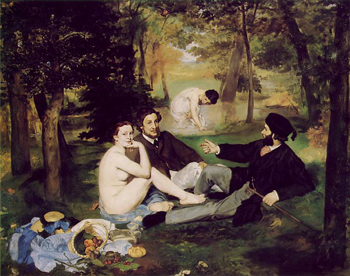| Search Art Prints | ||||||||||||||||||||
| Search Artists | ||||||||||||||||||||

|
||||||||||||||||||||
|
|
|||||||||||||||||||

Déjeuner sur l'herbealso known as The Picnic

|
It is hard to overstate the importance of Manet's Déjeuner sur l'herbe; it is one of the paintings that marks the beginning of modern art.
Déjeuner was first exhibited at the Salon des Refusés, an official exhibition ordered by Napoleon III himself in 1863. That year, the jury of the official Salon had been unusually harsh, and the Emperor's goal was to allow the public to judge the jurors. Déjeuner stole the show, and made history. It was the first work of modern art defined by scandal, only to be vindicated later by art historians.
Though it appears tame to our eyes--perhaps nothing more than a tasteful, masterfully painted nude--Déjeuner sur l'herbe ran so flagrantly in contradiction to the rigid Classicism of the art establishment at its time as to cause a complete uproar. The naked woman in the foreground is clearly no goddess, but a modern, contemporary woman, seated with two men (identified as students) in equally contemporary dress. She stares brazenly at the viewer, acknowledging his presence, and implies his participation in this immoral luncheon. In the background, a woman clad only in her chemise washes herself in a stream. Notable too is a large silver flask amongst the fruit and bread in the lower left-hand corner.
The subject matter was risqué on its own, but the construction is what cemented Déjeuner's succès du scandale. Manet painted the piece with large, sweeping brush strokes, found by some to be as crude as the subject. There was nothing linear, Classical, or elegant to offset the subject.
Now, 140 years later, Déjeuner sur l'herbe is recognized as one of Manet's best works, and a masterful technical achievement: the placement of life-sized figures in a landscape setting.











